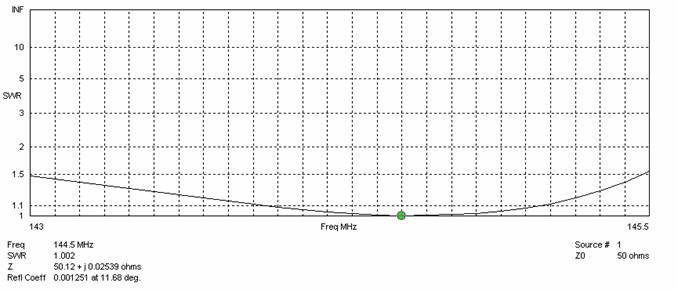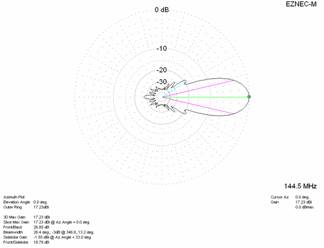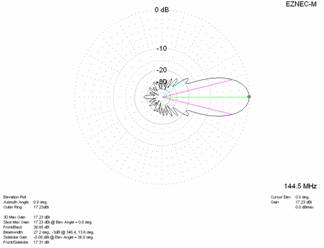
MORE ABOUT OBLONGS 3
By Slobodan Bukvic, YU7XL, yu7xl@nadlanu.com
In the last Dubus issues, I described super oblong antenna for 1296 and 432 MHz respectively. Now I want to show some models of oblong for 144 MHz.
The situation is quite different in which an antenna is considered, comparing to higher frequencies. The sky and the ground noise are much higher on 144 MHz. For the calculation, the temperature of the sky is adopted to be 1000K, and of the ground – 200K. Therefore, the performance of the oblong antennas cannot be so spectacularly better in comparison to the yagi. Anyway, they are better. But, the main advantage of oblong still remains – this is much bigger frequency bandwidth.
I have made several hundreds of oblong models for 144 MHz, using aluminum rods with diameter 3, 4 and 5 millimeters. I did not want to consider bigger diameter, because the element weight becomes impractical for building and for economical reasons. Smaller diameter is impractical, too, the elements becoming mechanically not strong enough.
Smaller diameter gives a little bit better performances, though the difference is almost negligible. You can choose among 3 or 4 or 5 millimeter rods, and the only good reason to think off is mechanical strength.
In the previous parts of this article I stated that the best results are obtained if the boom length is in the range of 10 to 20 wavelengths. Such a long antenna for 144 MHz is not possible. However, I have made several long boom models, just to prove this statement.
Further, a larger element height is better for the 144 MHz oblongs. It gives higher gain and better bandwidth, though their temperature is a bit higher. Accordingly, the G/T ratio is better, but too big height is not suitable, because modeling can become a nightmare and you will always get quite unexpectable results in performances – just like when trying to shape a rubber balloon by pressing. Suppressing one lobe, another unwanted lobe is coming up etc.
Anyway, the oblong is an interesting antenna for 144 MHz, too, worth of building and using. One can say it is hard to build, more expensive, etc. I do not agree. Both yagis and oblongs have advantages and disadvantages, but one simple advice has to be followed: put the oblong element isolated over the boom, not around the boom.
One thing more to explain: I am always designing antennas for a little bit higher central frequency. Once, when the antenna is erected on the tower (or put in stack), the central frequency will slide down due to surrounding influences.
Now let us see some oblong models for 144 MHz.
Ten elements oblong Q210XLS
Performance: (no loss condition)
|
TYPE |
ELE |
L (mm) |
G (dBi) |
F/B (dB) |
F/Sh (dBi) |
F/Sv (dBi) |
Hor (◦) |
Ver (◦) |
Temp (◦K) |
G/T (dB) |
ΔF * (MHz) |
|
Q210XLS |
10 |
6348 |
15,38 |
23,56 |
22,84 |
19,48 |
33,6 |
35,9 |
220,1 |
-8,05 |
2900 |
* ΔF given for SWR=1,5
|
Antenna |
Boomlength (mm) |
Material |
Gain (dBi) |
TA (◦K) |
G/T (dB) |
Bandwidth (MHz) |
|
Q210XLS |
6348 |
No loss |
15,38 |
220,1 |
-8,05 |
143,250-146,120 |
|
Aluminum |
15,29 |
221,7 |
-8,17 |
|||
|
EF0211-5 |
6325 |
No loss |
15,24 |
226,7 |
-8,31 |
142,500-144,750 |
|
Aluminum |
15,14 |
228,5 |
-8,45 |
Dimensions:
|
|
Ref |
De |
D1 |
D2 |
D3 |
D4 |
D5 |
D6 |
D7 |
D8 |
- All elements made of Al rods Ǿ5 mm - The height of all rectangles is 300 mm - All dimensions given in milimeters |
|
Pos |
0 |
310 |
653 |
1267 |
1976 |
2788 |
3649 |
4539 |
5389 |
6348 |
|
|
Length |
806 |
752 |
728 |
696 |
672 |
652 |
638 |
618 |
594 |
578 |
Table 1: 10 element oblong Q210XLS – Performance data, comparison with YU7EF yagi and dimensions
Diagrams (losses included)

Fig. 2: SWR sweep for the 10 ele 2m oblong antenna (EZNEC simulation, losses included)


Fig. 1: 10 element Oblong for 2m – Horizontal plane (left) and vertical plane (bottom)
(EZNEC simulation – losses included)
Twelve element oblong Q212XLK
Performance data: (No loss condition)
|
TYPE |
ELE |
L (mm) |
G (dBi) |
F/B (dB) |
F/Sh (dBi) |
F/Sv (dBi) |
Hor (◦) |
Ver (◦) |
Temp (◦K) |
G/T (dB) |
ΔF * (MHz) |
|
Q212XLK |
12 |
7225 |
15,98 |
22,85 |
21,42 |
19,75 |
31,4 |
32,9 |
220,0 |
-7,44 |
2630 |
* ΔF given for SWR=1,5
|
Antenna |
Boomlength (mm) |
Material |
Gain (dBi) |
TA (◦K) |
G/T (dB) |
Bandwidth (MHz) |
|
Q212XLK |
7225 |
No loss |
15,98 |
220,0 |
-7,44 |
142,850-145,480 |
|
Aluminum |
15,87 |
222,0 |
-7,59 |
|||
|
EF0212-5 |
7260 |
No loss |
15,91 |
224,0 |
-7,59 |
143,300-144,820 |
|
Aluminum |
15,81 |
226,0 |
-7,73 |
Dimensions:
|
|
Ref |
De |
D1 |
D2 |
D3 |
D4 |
D5 |
D6 |
D7 |
D8 |
D9 |
D10 |
|
Pos |
0 |
400 |
568 |
932 |
1385 |
2011 |
2808 |
3666 |
4532 |
5453 |
6355 |
7225 |
|
Length |
792 |
750 |
723 |
686 |
676 |
658 |
642 |
630 |
618 |
602 |
588 |
586 |
|
- All elements made of Al rods Ǿ5 mm - The height of all rectangles is 320 mm - All dimensions given in milimeters |
||||||||||||
Table 2: 12 element oblong Q212XLK – Performance data, comparison with YU7EF yagi and dimensions
Diagrams (losses included):



Fig. 3: 12 ele,emt Oblong for 2m – horizontal plane (left) and vertical plane (right)
(EZNEC sinulation – losses inckuded)
Fourteen element oblong Q214XLM
Performances: (no loss condition)
|
TYPE |
ELE |
L (mm) |
G (dBi) |
F/B (dB) |
F/Sh (dBi) |
F/Sv (dBi) |
Hor (◦) |
Ver (◦) |
Temp (◦K) |
G/T (dB) |
ΔF * (MHz) |
|
Q214XLM |
14 |
9045 |
17,39 |
26,66 |
18,84 |
17,33 |
26,4 |
27,3 |
220,2 |
-6,04 |
1,200 |
* ΔF given for SWR=1,5
|
Antenna |
Boomlength (mm) |
Material |
Gain (dBi) |
TA (◦K) |
G/T (dB) |
Bandwidth (MHz) |
|
Q214XLM |
9980 |
No loss |
17,39 |
220,2 |
-6,04 |
143,800-145,000 |
|
Aluminum |
17,23 |
223,1 |
-6,25 |
|||
|
EF0215-5 |
10060 |
No loss |
17,26 |
223,0 |
-6,22 |
143,750-144,460 |
|
Aluminum |
17,06 |
226,7 |
-6,49 |
Dimensions:
|
|
Ref |
De |
D1 |
D2 |
D3 |
D4 |
D5 |
D6 |
D7 |
D8 |
D9 |
D10 |
D11 |
D12 |
|
Pos |
0 |
344 |
544 |
1125 |
1875 |
2705 |
3572 |
4499 |
5409 |
6325 |
7315 |
8212 |
9178 |
9980 |
|
Length |
714 |
668 |
652 |
625 |
608 |
591 |
581 |
572 |
562 |
548 |
542 |
536 |
530 |
522 |
|
- All elements made of Al rods Ǿ5 mm - The height of all rectangles is 400 mm - All dimensions given in milimeters |
||||||||||||||
Table 3: 14 ele oblong Q210XLM – Performance data, comparison with YU7EF Yagi and dimensions
Diagrams (losses included)

Fig. 6: SWR sweeo for the 14 ele 2m oblong antenna (EZNEC simulation, losses included)


Fig. 5: 14 element Oblong for 2m – horizontal plane (left) and vertical plane (bottom)
(EZNEC simulation – losses included)